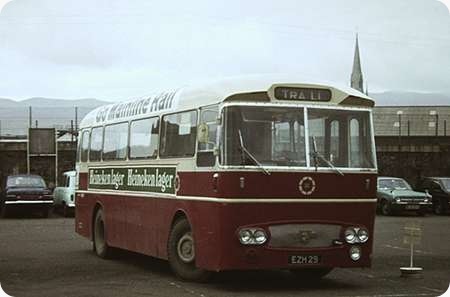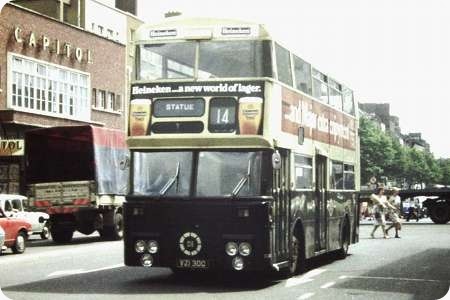CIE – Leyland Leopard – EZH 29 – C29
CIE (Coras Iompair Eirann)
1965
Leyland Leopard PSU3/4R
CIE / Metal sections B45F
Seen resting in Tralee, this fine looking machine was one of 183 similar vehicles delivered in 1965/66. Mechanically, they sported semi-automatic transmission, air suspension and power steering, and internally fluorescent lighting and forced air ventilation were fitted. Interestingly, they had single curvature windscreens, rather than the BET-style double curvature screens gaining favour elsewhere at the time. That said, the CIE type of screen did lend the Leopards a distinctive air.
Photograph and Copy contributed by Brendan Smith
07/05/13 – 18:02
Presumably in the bus depot yard on John Joe Sheehy Rd.
If only we had such interesting vehicles down here today instead of the unremitting diet of Sania/Irizar with a slight dilution of the one and only BMC (no, not them, I mean the Turkish outfit) school bus assigned to Tralee.
Phil Blinkhorn
09/05/13 – 07:44
Yes I think that’s the one Phil, if it’s the yard by the railway station (an ‘interchange?’). I sympathise with you on the lack of variety in Tralee nowadays. It sounds desperate, as my Irish grandparents used to say. Even in the late ‘seventies when the photo was taken, CIE still had quite a lot to offer the enthusiast. They could certainly muster Titan PD3s, Atlantean PDRs, Van Hool-McArdle-bodied Atlantean AN68s, Leopard Ls and PSUs, Bedford SB/MetSec schoolbuses, 12metre Leopard PSU coach and express vehicles with CIE/MetSec bodies, not to mention Leopard / Van Hool coaches, and the odd towing lorry converted from a full-fronted Tiger OPS. All that combined with wonderful scenery, friendly people and the best pints of Guinness in the world.
Brendan Smith
09/05/13 – 11:43
The yard is still there and the bus station building was redeveloped some years ago. "Interchange" is a bit of a misnomer as bus and train departures don’t tie up nowadays. The bus station is busiest on schooldays at around 08.45 and 16.00 when school buses abound – mainly from the CIE service fleet but augmented by private operators.
When we moved here from the UK 15 years ago there were a number of Bombardier single deckers, VC class Caetano bodied Volvos – then a couple of years old – even ex Singapore VS class Volvo B57s as school buses. Since then we’ve had some tatty ex West Midland Lynx and a couple of Plaxton bodied VR class Volvos.
Double deckers, other than the odd Neoplan tourist coach, are virtual rarities. There used to be a British registered PD3 at the local McDonald’s but that vanished in around 2006, leaving the Bus Eireann Bombardier open top double decker as the only "regular" visitor but even that goes missing in the rare years when Kerry doesn’t win the All Ireland Football Final.
Considering the range of vehicles in the fleet, we have very little to look at.
Phil Blinkhorn
06/11/18 – 08:53
It should be noted that this livery layout was unusual on the C class Leopards with the original pointed roof ends (as on this bus) — all except two were all red with just the roof in cream. When the roof ends were altered to a flatter profile several buses had the cream applied down to waist level. Approximately two dozen buses of the 270 strong fleet did not have the roof ends altered.
Shane Conway
Quick links to the - Comments Page - Contact Page - Home Page



